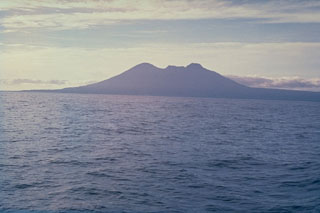Report on Long Island (Papua New Guinea) — January 1979
Scientific Event Alert Network Bulletin, vol. 4, no. 1 (January 1979)
Managing Editor: David Squires.
Long Island (Papua New Guinea) New fumarolic activity
Please cite this report as:
Global Volcanism Program, 1979. Report on Long Island (Papua New Guinea) (Squires, D., ed.). Scientific Event Alert Network Bulletin, 4:1. Smithsonian Institution. https://doi.org/10.5479/si.GVP.SEAN197901-251050
Long Island
Papua New Guinea
5.358°S, 147.12°E; summit elev. 1280 m
All times are local (unless otherwise noted)
"A report was received on 26 January of a supposed eruption of Motmot cone about mid-January. A flypast by a volcanologist on 15 January had revealed nothing unusual. However, aerial inspections on 29 January indicated considerable new vapour emission, including one powerful fumarole that was jetting white vapour and possibly water at the W shoreline of Motmot Island (350 m in diameter). Vapour from this jet obscured details nearby, but no clear evidence of recent eruptive activity was noted. No new craters or cones were present, and no new ejecta could be recognised on the island. Pending further information, it is assumed that only vapour activity has occurred so far."
Geological Summary. The broad profile of hexagonal-shaped Long Island is dominated by two steep-sided stratovolcanoes, Mount Reaumur in the north and Cerisy Peak in the south. Collapse of the basaltic-andesitic volcanic complex produced a large 10 x 12.5 km caldera, now filled by Lake Wisdom. Caldera formation occurred during at least three major explosive eruptions, about 16,000, 4000, and 300 years ago. The latter was one of the largest historical eruptions in Papua New Guinea and deposited andesitic tephra across the New Guinea highlands, prompting legends of a "Time of Darkness." Post-caldera eruptions have constructed a small cone, Motmot Island, in the south-central part of Lake Wisdom. Moderate explosive eruptions have occurred during the 20th century from vents at and near Motmot Island.
Information Contacts: R. Cooke, RVO.

